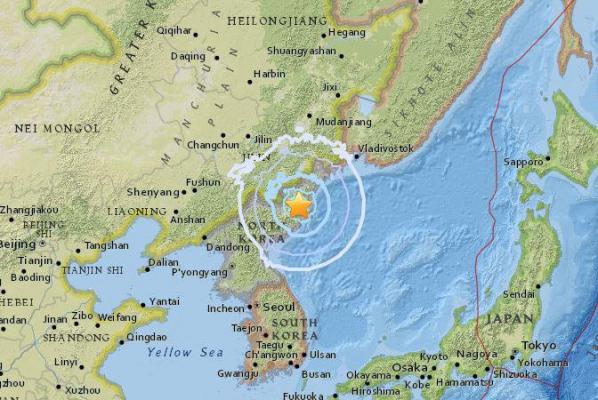
Sept. 3 (UPI) — North Korea announced Sunday it successfully tested a hydrogen nuclear bomb that can be loaded onto a new intercontinental ballistic missile and is 10 times stronger than its previous detonation.
Korea’s sixth underground bomb tested since 2006 was condemned by leaders worldwide, including U.S. President Donald Trump who said the regime’s “words and actions continue to be very hostile and dangerous to the United States.
The state-run Korean Central News Agency announced the completion of the test at noon Pyongyang Time, calling it a “perfect” success.
The U.S Geological Survey said a 6.3 magnitude earthquake was detected near North Korea’s known nuclear test site in Punggye-ri, in the county’s northeast region. It had a depth of 14.3 miles.
The “artificial quake” was 9.8 times as powerful as the the last test in September 2016, South Korea’s state weather agency said. The 5.3-magnitude earthquake then was about as powerful as the bomb the United States dropped on Hiroshima, Japan, in 1945, that was 15,000 tons of TNT.
“The H-bomb test was carried out to examine and confirm the accuracy and credibility of the power control technology, and internal structural design newly introduced into manufacturing the H-bomb to be placed as the payload of the ICBM,” the Korean Central News Agency said.
The earthquake was felt in northern China in Yanji, near the North Korean border, according to local media.
China’s Earthquake Administration said it had detected a second tremor, just after the first, of 4.6 magnitude which it termed as “a collapse.”
The foreign ministry of China, which is North Korea’s only major ally, said in a statement that North Korea “has ignored the international community’s widespread opposition, again carrying out a nuclear test. China’s government expresses resolute opposition and strong condemnation toward this.”
Russia said the test defied international law and that the only way to resolve the Korean peninsula’s problems, “including the nuclear one,” was for all sides involved to hold talks.
South Korean President Moon Jae-in and Japanese Prime Minister Shinzo Abe called emergency meetings of their national security councils after the test, which is outlawed by U.N. sanctions.
South Korea’s presidential chief security adviser said: “During the meeting, we decided to discuss measures to deploy the strongest U.S. military assets that the U.S. military has in line with the U.S.-South Korea alliance and to show off our military’s strike capabilities to neutralize North Korea’s nuclear facilities and missiles.
Defense Minister Itsunori Onodera said the ministry began flying “sniffer” planes capable of detecting radioactive fallout.
On Tuesday, North Korea launched a long-range intercontinental ballistic missile over Japan.
“The fact that North Korea forced through a nuclear test this time is absolutely unacceptable to our country,” Japanese Prime Minister Shinzo Abe said in a statement. “North Korea’s nuclear and missile development programm is a threat that is more grave and urgent to the safety of our country and has entered a new stage. It is significantly hurting regional and international peace and stability.”
Trump reacted strongly in a series of tweets on Sunday morning from the White House: “North Korea has conducted a major Nuclear Test. Their words and actions continue to be very hostile and dangerous to the United States. North Korea is a rogue nation which has become a great threat and embarrassment to China, which is trying to help but with little success.”
He added: “South Korea is finding, as I have told them, that their talk of appeasement with North Korea will not work, they only understand one thing!”
On Sunday, North Korean leader Kim Jong Un reportedly inspected a “super explosive” hydrogen bomb for its intercontinental ballistic missiles and “guided the work for nuclear weaponization.” Pyongyang said it had miniaturized a hydrogen bomb for use on a long-range missile.
“The H-bomb, the explosive power of which is adjustable from tens kiloton to hundreds kiloton, is a multi-functional thermonuclear nuke with great destructive power which can be detonated even at high altitudes for super-powerful EMP [electromagnetic pulse] attack according to strategic goals,” KCNA reported in English.
In hydrogen bombs, fusion — the merging of atoms — is used to unleash energy, whereas atomic bombs use nuclear fission, or the splitting of atoms.
North Korea’s first claimed to have tested a hydrogen bomb in January 2016, during their fourth nuclear test. Other countries doubted the claim for lack of evidence. Experts said North Korea may have tested a “boosted” atomic bomb.
North Korea launched two intercontinental missiles on July 4 and 28. In the latest test, North Korea said it launched its Hwasong-14 intercontinental ballistic missile than can reach most of the United States.
Trump has warned he would unleash “fire and fury” against North Korea if it continued to threaten the United States with nuclear missiles. North Korea has threatened to launch a missile near Guam, a U.S. territory.
After Tuesday’s missile test, Trump said “all options are on the table” in response to the regime’s “threatening and destabilizing actions.”






